Tourism in Ladakh
Tourism is one of an economic contributor to the union territory of Ladakh in Northern India. The union territory is part of the broader disputed Kashmir region and is sandwiched between the Karakoram mountain range to the north and the Himalayas to the south and is situated at the height of 11,400 ft. Ladakh is composed of the Leh and Kargil districts. The region contains prominent Buddhist sites and has an ecotourism industry. As of 2020, tourism industry in Ladakh was worth ₹600 crore (US$84 million).[1]

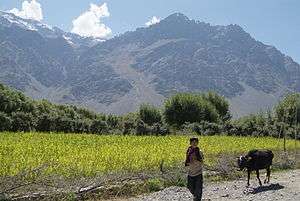
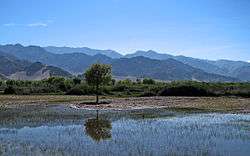
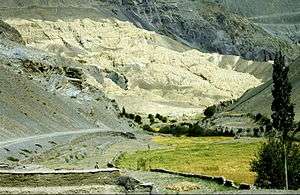
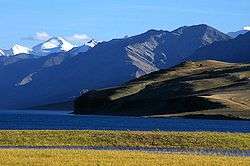
Transport
The two roads into the area from outside are the Zoji-La Pass and Kargil route from Srinagar District in the Kashmir Valley, and the high altitude Manali-Leh Highway from Himachal Pradesh. The Manali-Leh road is open only from May or June to October or November when snow is cleared from several passes. The Srinagar-Leh road is open from April or May to November or December[2] and is generally blocked by snow through the winter only at Zoji La Pass.
Kushok Bakula Rimpochee Airport at Leh has flights from Delhi year-round on Jet Airways, Vistara, GoAir, and Air India. Air India also operates weekly flights to Jammu and Srinagar.[3]

Roads within Ladakh, except to Zangskar, are open all year round. Khardong-La Pass to Nubra can get closed by snow for several days in winter and spring. Chang-La pass to Pangong Lake rarely closes.
Buses serve the whole area from Leh and Kargil towns. Taxis are available in Leh and Kargil as well as in block headquarters like Tangtse, Diskit, and Khalsa. Shared taxis to Nubra, Kargil, Srinagar, and Zanskar leave Leh in the early morning.
The nearest railhead is Udhampur connected with all major cities and towns in India.
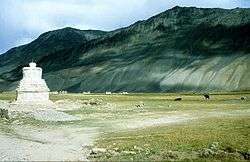
Tourist places
Among the places of tourist interest include Leh, Drass valley, Razi khar (Chiktan Khar), Suru valley, Kargil, Zangskar, Zangla, Rangdum, Padum, Phukthal, Sani Monastery, Stongdey, Shayok Valley, Sankoo, Salt Valley. Treks include Manali to Ladakh, the Nubra valley, Pangong tso, Tso moriri, the Indus valley[4], Markha valley, Ladakh monastery trek, South Zangskar, Trans-Zangskar Expedition, Spiti to Ladakh, Spiti to Pitok to Hemis, Rupshu, the Great Salt lakes, Chadar Ice trek[5], Padum-Phuktal, Padam to Darcha, Panikhar to Heniskot, Padum to Manali, Lamayuru-Martselang, Lamayuru - Alchi, Kala Pattar trek, Pahal
Other locations
The Razi Khar (Chiktan kahr/Chiktan Palace), which is situated 76 km from Kargil and 180 km from Leh is situated on the highway from Kargil to Leh, and is the first Palace of the then ruler Thatha Khan.
The Leh Palace, which is situated behind the main market has eight stories and is similar to the Potala Palace of Lhasa and still belongs to the royal family of Ladakh. Just ahead of the palace is the Chamba Temple, which is a one roomed shrine that has a large icon of Maitreya, the Buddha to come.
Also in the bazaar, at the top of the street, one can see the Jama Masjid. This has been painted in green and white colour. Another place to visit is the Sankar Gompa, which is situated in the city and is one of the oldest structures here. At one time, this monastery only welcomes a maximum of twenty monks.
The Thikse Monastery is the largest monastery in central Ladakh and is primarily known for its statue of Maitreya in its Maitreya Temple. This statue is 15 m (49 ft) high and the largest such statue in Ladakh. The Buddha is unusually portrayed as seated in the lotus position rather than his usual representations as standing or in a sitting posture on a high throne.[3]

About 65 km west of Leh, towards Zanskar river, is the village of Sumda Chun at height of 3500 mtr. The monastery of Sumda-Chun is one of the most important surviving early Tibetan Buddhist temples of the Ladakh region. [6]

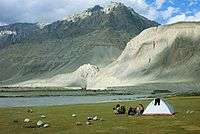
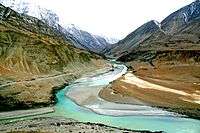
Permits and borders
No special permit is required to visit most of Ladakh, including Leh and Kargil towns. Permits are required for all tourists to visit the "Inner Line" areas, i.e. Nubra Valley; Panggong Lake and the Durbuk Block that it lies in (i.e. north of the Changla Pass); Tso-Moriri and Tsokar Lakes and the area along the Indus River east of Upshi; and Dha-hanu and the area along the Indus River northwest of Khalatse.
Permits are not available for foreigners to go to the far reaches of each of the areas close to the borders (or Line of Control, etc.) with Pakistan and China. For example, foreigners can go to the edge of Panggong Lake and Maan and Merak villages, but not along the edge of it to Phobrang or Chushul villages; they cannot proceed east up the Indus from the Mahe Bridge; and in Nubra, they can only go as far as Panamik to the north and Turtuk to the west.
There are no open border crossings between Ladakh and the neighbouring Tibet Autonomous Region.
Ecotourism in Ladakh
Due to the strain that tourism can cause on local resources, the concept of ecotourism has been introduced in Ladakh by non-governmental organizations and individuals like Helena Norberg-Hodge and Thinlas Chorol.
In May 2001, The Mountain Institute, Ladakh Ecological Development Group and Snow Leopard Conservancy organized a workshop on "Ecotourism Opportunities in Rural Ladakh"[7] in the city of Leh in order to "increase awareness" and "explore opportunities for ecotourism".
Buddhist tourism in Ladakh
There are about 35 Buddhist monasteries spread across the region which thrives on donations made by tourists and the local people of the region but now the government plans to develop these monasteries.
The state government also plans to hire experts for landscaping of the barren regions and such a move was possible only after the Centre released funds.[8][9]
References
- Bhatia, Varinder (28 June 2020). "Ladakh's long, hot summer". The Indian Express. Retrieved 22 July 2020.
- "Leh Ladakh Trip in December". Backpackclan. Retrieved 12 December 2019.
- Ladakh, The mountain kingdom. "tourism in ladakh". The Times Of India. Retrieved 6 February 2014.
- "Most Visited Places in Ladakh". Deepak. Retrieved 24 February 2020.
- Chadar, Trek. "Chadar Ice trek". Deepak. Retrieved 2 February 2020.
- "Sumda Chun Monastery". World Monuments Fund. Retrieved 13 December 2018.
- Ecotourism Opportunities in Rural Ladakh-Workshop Report
- Ladakh, Leh (8 July 2012). "Buddhist Tourism". Z News. Retrieved 6 February 2014.
- Tourism in Ladakh
External links
| Wikivoyage has a travel guide for Ladakh. |